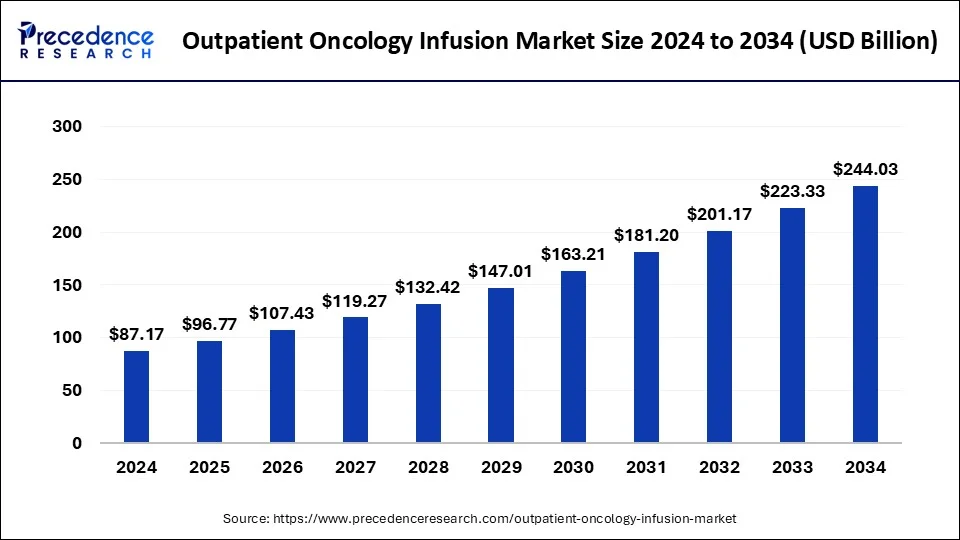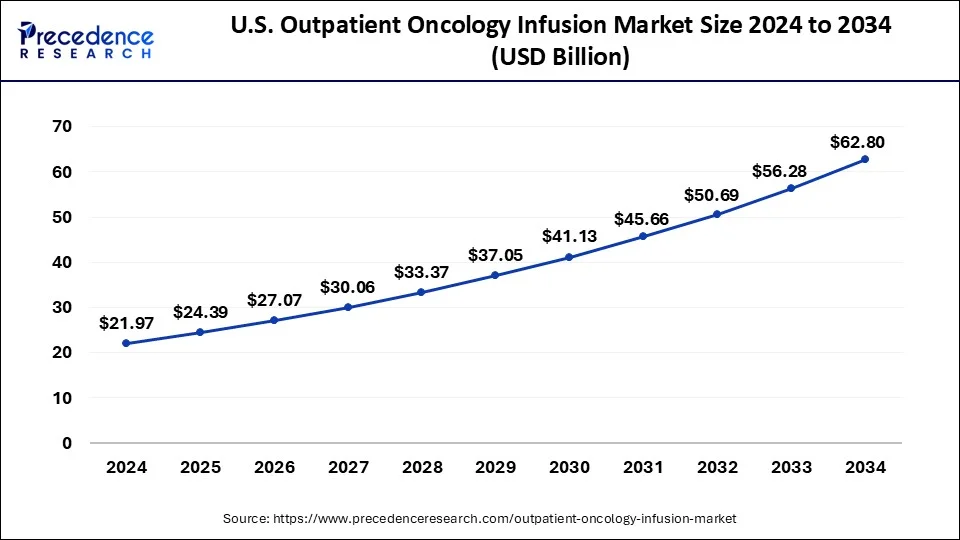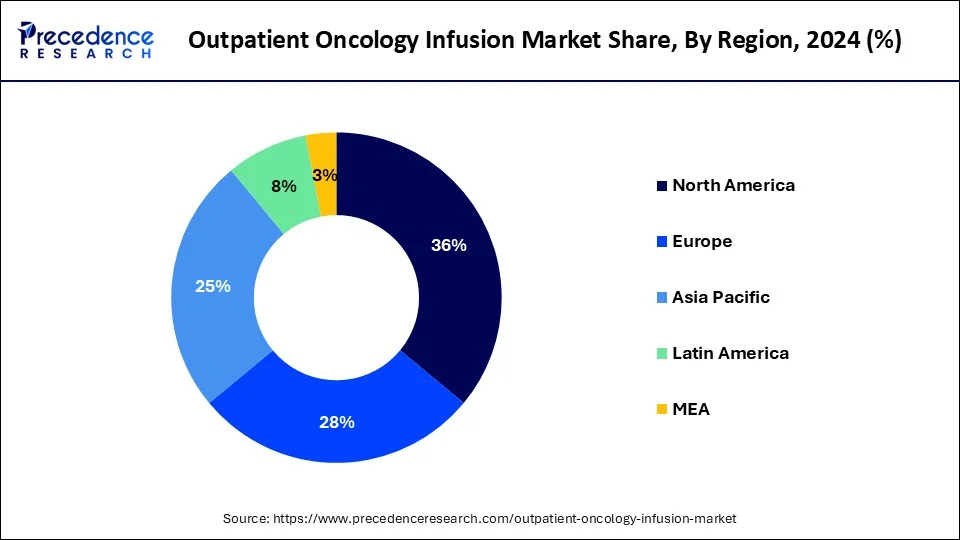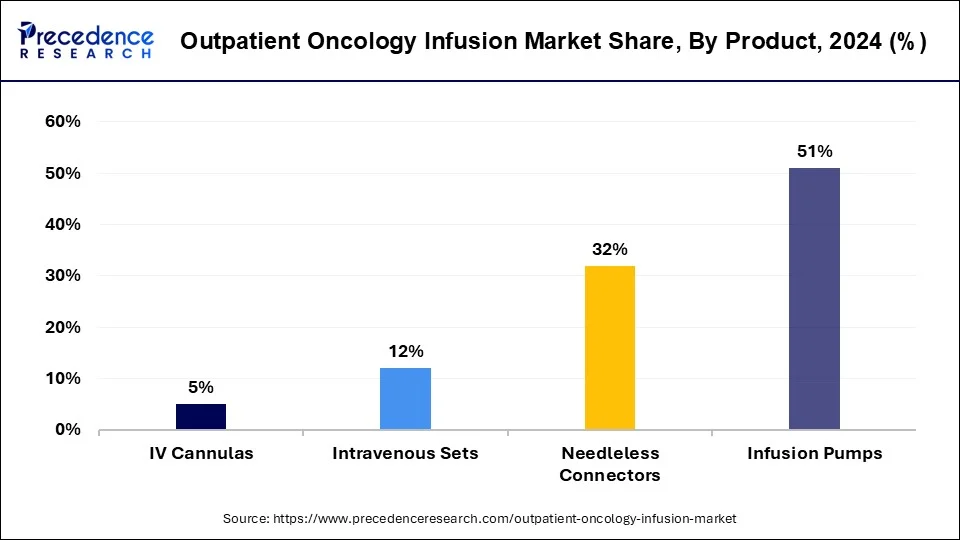August 2024
The global outpatient oncology infusion market size is calculated at USD 96.77 billion in 2025 and is forecasted to reach around USD 244.03 billion by 2034, accelerating at a CAGR of 10.84% from 2025 to 2034. The North America outpatient oncology infusion market size surpassed USD 31.38 billion in 2024 and is expanding at a CAGR of 11% during the forecast period. The market sizing and forecasts are revenue-based (USD Million/Billion), with 2024 as the base year.
The global outpatient oncology infusion market size was USD 87.17 billion in 2024, estimated at USD 96.77 billion in 2025 and is anticipated to reach around USD 244.03 billion by 2034, expanding at a CAGR of 10.84% from 2025 to 2034. Growing demand for outpatient oncology infusion therapy to treat cancer and a sudden surge in the prevalence of fatal diseases like cancer are the reasons driving the market's growth on a global scale.

The U.S. outpatient oncology infusion market size surpassed USD 21.97 billion in 2024 and is expected to be worth around USD 62.80 billion by 2034 at a CAGR of 11.07% from 2025 to 2034.

North America held the largest market share and dominated the market globally. Furthermore, it is expected to continue its growth. In the region, the outpatient oncology infusion market is robust and continuously evolving. The region boasts advanced healthcare infrastructure, a high prevalence of cancer cases, and a strong emphasis on innovation, driving the expansion of outpatient oncology infusion services. This shift towards outpatient settings aligns with the preferences of both patients and healthcare providers, promoting convenience and flexibility in cancer treatment delivery. One notable trend in North America is the increasing adoption of outpatient care models, fueled by efforts to reduce healthcare costs and improve patient experience.
Moreover, the United States is at the forefront of technological advancements in oncology, with a focus on personalized medicine, targeted therapies, and immunotherapy. These innovative treatment modalities are reshaping the landscape of outpatient oncology infusion, offering more precise and effective options for patients. The region also benefits from supportive government policies and robust reimbursement frameworks, which incentivize the expansion of outpatient oncology infusion services.
Additionally, Canada shows strategic collaborations between healthcare institutions, research organizations, and pharmaceutical companies drive advancements in cancer care and contribute to the growth of the market. Therefore, North American presents a dynamic environment for the outpatient oncology infusion market, characterized by innovation, accessibility, and a commitment to improving patient outcomes.

Asia Pacific is emerging as a fast-growing market for outpatient oncology infusion services. Several factors contribute to this growth trajectory. The region is experiencing a significant increase in cancer incidence, attributed to various factors such as population aging, lifestyle changes, and environmental factors. Many countries in Asia Pacific, such as India, China, Japan, and Korea, are investing heavily in healthcare infrastructure development, including the establishment of outpatient clinics and infusion centers dedicated to oncology care.
With rising awareness and increasing affordability, there is a growing demand for advanced oncology treatments, including chemotherapy and immunotherapy, which are often administered in outpatient settings. Pharmaceutical companies are expanding their presence in Asia Pacific, bringing innovative oncology drugs and therapies to the market and driving the growth of outpatient infusion services. Governments across the region are implementing policies to improve cancer care and access to treatment, which includes supporting the development of the outpatient oncology infusion market.
The adoption of advanced medical technologies and telemedicine solutions further facilitates the delivery of outpatient oncology infusion services, especially in remote or underserved areas. These factors collectively contribute to Asia Pacific’s status as a fast-growing outpatient oncology infusion market, with significant opportunities for further expansion and development.
The outpatient oncology infusion market is witnessing notable growth due to increasing cancer cases and advancements in treatment. With a shift towards outpatient care, clinics and infusion centers are becoming preferred choices for chemotherapy and other infusion therapies. The market is poised for continued growth as it adapts to meet the evolving needs of cancer patients and healthcare providers worldwide.
Benefits such as convenience, reduced hospital stays, and lower costs fuel this trend. Technological innovations like targeted therapies and immunotherapy are shaping the market landscape. Moreover, supportive government initiatives and insurance coverage further drive the expansion of the outpatient oncology infusion market. Competition among critical players intensifies as they focus on providing quality care, enhancing patient experience, and expanding their service offerings.
| Report Coverage | Details |
| Market Size in 2024 | USD 87.17 Billion |
| Market Size in 2025 | USD 96.77 Billion |
| Market Size by 2034 | USD 244.03 Billion |
| Market Growth Rate from 2025 to 2034 | CAGR of 6.01% |
| Largest Market | North America |
| Base Year | 2024 |
| Forecast Period | 2025 to 2034 |
| Segments Covered | Product, Application, Therapy, Therapy, and Region |
| Regions Covered | North America, Europe, Asia-Pacific, Latin America, and Middle East & Africa |
Prevalence of cancer
The rising prevalence of cancer globally, attributed to factors like aging populations, lifestyle changes, and environmental factors, is a significant driver for the outpatient oncology infusion market. As more people are diagnosed with cancer, there is a corresponding increase in the need for chemotherapy and other infusion therapies. Outpatient settings offer several advantages over traditional inpatient care, including convenience, reduced hospital stays, and lower costs.
Patients often prefer the flexibility and comfort of receiving treatment in clinics or infusion centers, allowing them to maintain a sense of safety. Additionally, outpatient care aligns with healthcare trends focused on shifting from expensive hospital-based care to more efficient and accessible community-based services. Thus, the growing prevalence of cancer is a key driver propelling the expansion of the outpatient oncology infusion market.
Reimbursement challenges
A major restraint in the outpatient oncology infusion market is the complex reimbursement landscape and reimbursement challenges. Despite the growing demand for outpatient cancer care, reimbursement policies and mechanisms can be intricate and vary widely across different regions and healthcare systems. Obtaining reimbursement approval for specific treatments or medications may be lengthy, delaying patient access to necessary care. These reimbursement challenges can hinder the growth and expansion of outpatient oncology infusion services and limit their availability and accessibility to patients in need.
Reimbursement rates may not always adequately cover the costs of infusion therapies, leading to financial strain on healthcare providers and facilities. Moreover, frequent changes in reimbursement policies and regulations can create uncertainty and administrative burdens for providers, impacting their ability to deliver and manage outpatient oncology infusion services efficiently. As a result, navigating the complex reimbursement landscape remains a significant restraint in developing and advancing the outpatient oncology infusion market.
Telemedicine and remote monitoring
One significant opportunity for the outpatient oncology infusion market lies in integrating telemedicine and remote monitoring technologies. Telemedicine allows healthcare providers to deliver cancer care remotely, offering consultations, monitoring, and even some infusion therapies without requiring patients to visit physical clinics or infusion centers. This presents a significant opportunity to improve access to care, particularly for patients in rural or underserved areas who may face barriers to accessing specialized oncology services. By leveraging telemedicine technologies, healthcare providers can extend their reach and provide timely interventions, enhancing patient outcomes and satisfaction.
Furthermore, remote monitoring technologies enable healthcare teams to remotely monitor patients' vital signs, symptoms, and treatment adherence, proactively managing side effects and complications. This can lead to better treatment outcomes, reduced hospitalizations, and improved quality of life for patients undergoing outpatient oncology infusion therapies.
The integration of telemedicine and remote monitoring technologies enhances patient care and offers operational efficiencies for healthcare providers by optimizing resource utilization and reducing extra costs associated with traditional in-person visits. Thus, embracing these technologies presents a compelling opportunity to expand the reach and effectiveness of outpatient oncology infusion services.
The infusion pump segment held the largest share of the global market for outpatient oncology infusion in 2024. The growth is attributed to the rising number of cancer patients globally, inclined to treat the patients by using infusion pumps for therapy by medical professionals. Infusion pumps in this segment are often compact, portable, and user-friendly, allowing patients to undergo treatment comfortably in clinics or at home.

In the outpatient oncology infusion market, infusion pumps are critical in delivering medication safely and efficiently. These devices are designed to administer precise doses of chemotherapy drugs, hydration fluids, and other medications to cancer patients receiving treatment outside of a hospital setting. With programmable settings, alarms, and remote monitoring capabilities, these pumps ensure accurate delivery while minimizing the risk of complications. As outpatient oncology continues to grow, infusion pump manufacturers focus on innovation to meet the evolving market needs.
The lung cancer segment held the largest revenue share of the outpatient oncology infusion market. This segment commands a significant portion of the market due to its prevalence and clinical significance. Lung cancer is one of the most diagnosed cancers globally and remains a leading cause of cancer-related mortality.
Diagnostic tools and technologies tailored specifically for lung cancer detection and staging dominate this segment. Treatment modalities for lung cancer encompass a diverse array of options, including surgery, chemotherapy, radiation therapy, targeted therapy, and immunotherapy. Each of these interventions targets different aspects of the disease. Within this segment, targeted therapy and immunotherapy have emerged as particularly influential modalities, offering patients specific genetic mutations and effective treatment options.
Supportive care measures also play a crucial role in the management of lung cancer, addressing treatment-related side effects, improving symptom control, and enhancing the overall quality of life for patients. Care services, including pain management, nutritional support, and psychosocial interventions, are integral components of comprehensive lung cancer care, ensuring that patients receive holistic and compassionate support throughout their treatment journey. Given the continued prevalence and clinical significance of lung cancer, this segment remains at the forefront of oncology research, innovation, and clinical practice.
The chemotherapy segment dominated the outpatient oncology infusion market in 2024. As a systemic therapy, chemotherapy is used to treat various types of cancer by targeting rapidly dividing cells throughout the body, including cancer cells. The chemotherapy segment of the market encompasses a wide range of drugs, formulations, and delivery methods tailored to meet the specific needs of patients and their respective cancer types. Traditional chemotherapy agents, such as platinum-based drugs, continue to be widely utilized, particularly in combination with other treatment modalities like surgery, radiation therapy, and newer targeted therapies.
While traditional chemotherapy is associated with side effects such as nausea, hair loss, and immune suppression, advancements in drug development have led to the introduction of novel chemotherapy agents with improved efficacy and tolerability profiles. These newer agents may exhibit greater selectivity for cancer cells, resulting in fewer adverse effects on healthy tissues.
In addition to standalone chemotherapy, combination regimens incorporating multiple drugs or modalities are often employed to enhance treatment efficacy and overcome drug resistance. Anti-nausea medications, growth factors to stimulate white blood cell production, and medications to mitigate neuropathy are among the supportive therapies commonly utilized in conjunction with chemotherapy.
Despite the emergence of alternative treatment modalities, chemotherapy remains a vital component of cancer care, particularly in cases where other options may be less effective or unavailable. It also encompasses supportive care measures aimed at managing treatment-related side effects and improving patient comfort and quality of life. As research continues to unravel the complexities of cancer biology and drug resistance mechanisms, the chemotherapy segment of the oncology market is expected to witness ongoing innovation, leading to more personalized treatment approaches for patients battling cancer.
The intravenous (IV) mode segment is a dominant force in the outpatient oncology infusion market. IV therapy, characterized by the direct administration of fluids, medications, and nutrients into the bloodstream, plays a pivotal role in various medical applications, ranging from chemotherapy delivery to hydration therapy and emergency interventions. Additionally, IV administration facilitates the delivery of supportive care medications such as antiemetics, analgesics, and hydration fluids to manage treatment-related side effects and maintain patient comfort.
In oncology, the IV mode segment is instrumental in delivering chemotherapy agents, immunotherapy drugs, and supportive care medications to cancer patients. Intravenous chemotherapy remains a cornerstone of cancer treatment, allowing for precise dosing and continuous infusion of cytotoxic drugs directly into the systemic circulation to target tumor cells. Intravenous therapy enables the administration of life-saving medications, blood products, and fluids to patients in critical condition, ensuring timely delivery and efficacy in emergency situations.
Beyond oncology, the IV mode segment extends its reach to critical care units, emergency departments, and surgical settings, where rapid and reliable access to the bloodstream is essential for patient stabilization and intervention. As healthcare systems worldwide continue to evolve, the intravenous mode segment remains at the forefront of patient care, providing essential support for a wide range of medical interventions and therapeutic modalities. With ongoing research and technological innovation driving improvements in IV therapy delivery, this segment is poised to maintain its dominant position in the healthcare market, ensuring optimal outcomes for patients across diverse clinical settings.
By Product
By Application
By Therapy
By Mode
By Geography
For inquiries regarding discounts, bulk purchases, or customization requests, please contact us at sales@precedenceresearch.com
No cookie-cutter, only authentic analysis – take the 1st step to become a Precedence Research client
August 2024
August 2024
September 2023
November 2024